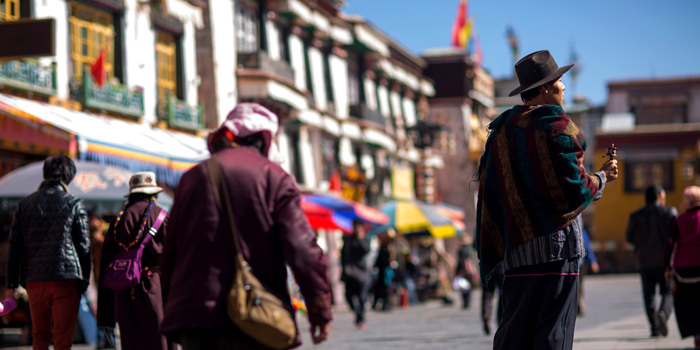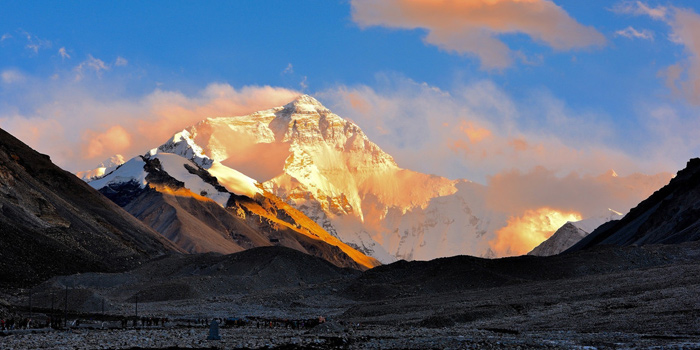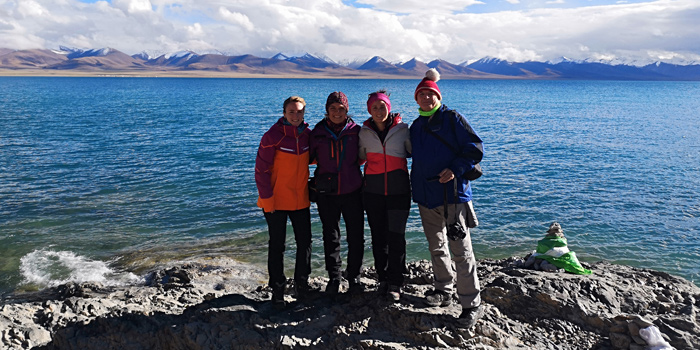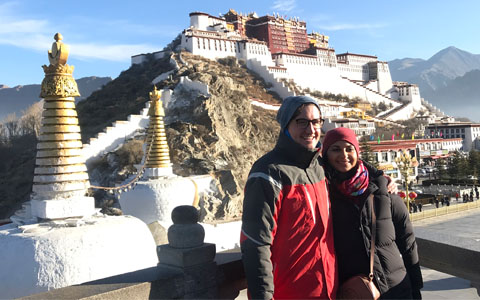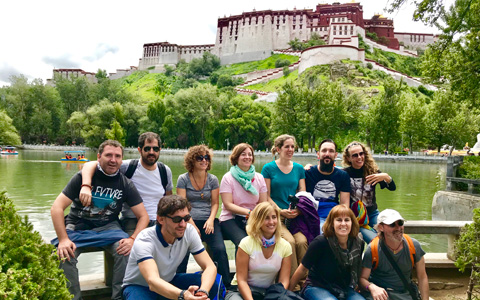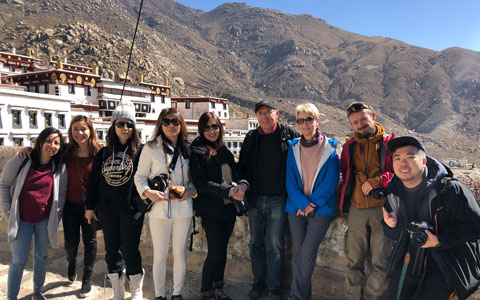Tibetan Plateau Facts: 15 Unique & Interesting Facts to Know
The Tibetan Plateau is renowned for its stunning beauty, attracting adventurers, tourists, geologists, and people from all walks of life. But what other fascinating facts and tidbits might you not know about this remarkable place?
There's a lot more to discover about the Tibetan Plateau, including its natural wonders, diverse ethnicities, and technological marvels. Here, we've compiled 15 intriguing facts about this extraordinary destination.
 1. The Tibetan Plateau is the Roof of the World
1. The Tibetan Plateau is the Roof of the World
 2. The Tibetan Plateau is the largest plateau in the world
2. The Tibetan Plateau is the largest plateau in the world
 3. Not all places on the Tibetan Plateau need the Travel Permit
3. Not all places on the Tibetan Plateau need the Travel Permit
 4. The Tibetan Plateau is the Third Pole of the planet
4. The Tibetan Plateau is the Third Pole of the planet
 5. The Tibetan Plateau owns the World’s Highest Peak
5. The Tibetan Plateau owns the World’s Highest Peak
 6. Besides Mt.Everest, there are other 7 peaks over 8000 on the Tibetan Plateau
6. Besides Mt.Everest, there are other 7 peaks over 8000 on the Tibetan Plateau
 7. There are a total 8 mountain ranges in the Tibetan Plateau
7. There are a total 8 mountain ranges in the Tibetan Plateau
 8. The Tibetan Plateau used to be an ocean
8. The Tibetan Plateau used to be an ocean
 9. Not only Tibetans live on the Tibetan Plateau
9. Not only Tibetans live on the Tibetan Plateau
 10. The Tibetan Plateau offers the longest highland railway in the world
10. The Tibetan Plateau offers the longest highland railway in the world
 11. The Tibetan Plateau also has high-speed Railways
11. The Tibetan Plateau also has high-speed Railways
 12. The once-isolated Tibetan Plateau now has airports, railway stations, and highways
12. The once-isolated Tibetan Plateau now has airports, railway stations, and highways
 13. The Tibetan Plateau is the source of the major rivers in Asia
13. The Tibetan Plateau is the source of the major rivers in Asia
 14. You may see snow in summer at some mountain passes in the Tibetan Plateau
14. You may see snow in summer at some mountain passes in the Tibetan Plateau
 15. There are Large temperature differences between day and night on the Qinghai-Tibet Plateau
15. There are Large temperature differences between day and night on the Qinghai-Tibet Plateau
1. The Tibetan Plateau is the Roof of the World
The Tibet Plateau itself is incredibly high, with an average elevation of 4,500 meters (14,700 feet). This means that the Tibetan Plateau, as a whole, is higher than most other countries’ individual higher peaks.
While the Tibetan Plateau's high altitude offers breathtaking landscapes, it's important to be aware of altitude sickness, also known as Acute Mountain Sickness (AMS), when traveling to Tibet.
Altitude sickness refers to the symptoms of shortness of breath, dizziness, tiredness, and headaches that can occur when you ascend to an unusually high altitude. It's essential to take necessary precautions and acclimatize properly to ensure a safe and enjoyable journey in Tibet.
So, it’s important to be prepared for that when visiting the Tibetan Plateau and knowing some of the ways to deal with it such as:
● Take breaks and rest periods during your ascent to allow your body to adjust.
● Stay hydrated by drinking plenty of water to combat dehydration caused by the dry climate and higher elevation.
● Avoid further ascent for the next 24 to 48 hours to give your body time to acclimatize.
● Refrain from consuming alcohol or smoking until you feel better, as these can worsen the effects of altitude sickness.
2. The Tibetan Plateau is the largest plateau in the world
While Tibet itself is 1,228,000 square kilometers (or about 474,133 square miles) large, the entire Tibetan Plateau is 2,500,000 square kilometers (or 970,000 sq mi) as it spills over into parts of the Qinghai Province, Sichuan Province, and Yunnan Province of China. For reference, that’s about 5 times the size of France or almost the entirety of Argentina.
3. Not all places on the Tibetan Plateau need the Travel Permit
Visiting Tibet requires a Tibet Travel Permit as well as a valid passport and a Chinese Visa. However, it doesn’t apply to the entirety of the Tibetan Plateau – just to the Tibet Autonomous Region.
 A Sample of Tibet Entry Permit
A Sample of Tibet Entry Permit
If you want to experience Tibetan culture in the plateau without a Travel Permit, you can arrange your trip to the rest of the Tibetan Plateau in Sichuan, Qinghai, and Yunnan.
4. The Tibetan Plateau is the Third Pole of the planet
A nickname such as “The Third Pole” can seem tacky at first but it is actually quite apt. That’s because the Tibetan Plateau isn’t just the tallest area of the planet but it also contains the widest and richest ice fields on the planet, right behind the north and south poles.
5. The Tibetan Plateau owns the World’s Highest Peak
Mount Everest, standing at an impressive height of 8,848.86 meters (or 29,031.7 feet), is a world-renowned peak that requires no introduction. Its summit point lies directly on the border between China and Nepal. Adventurers can choose from two routes to reach the pinnacle: a southeast route from Nepal or a northern route from Tibet.
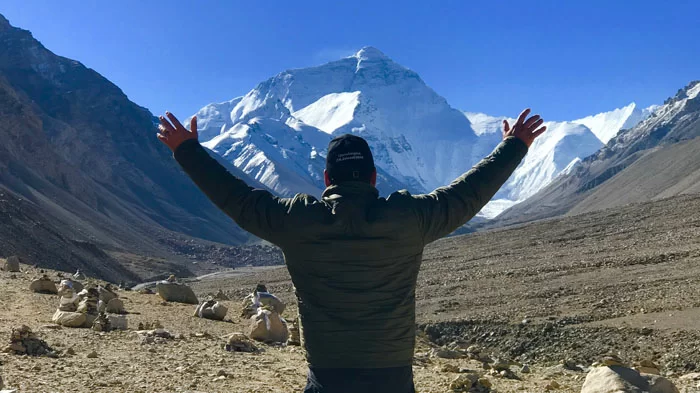 The Everest Base Camp Tour in Tibet is the closest get to the top of the world.
The Everest Base Camp Tour in Tibet is the closest get to the top of the world.
In recent times, Mount Everest has witnessed a surge in tourist interest, as more and more individuals are drawn to the allure and prestige of conquering the world's highest peak. The challenge of reaching the top of the world has become a compelling ambition for many.
And for most ordinary tourists with no mountaineering experience,an Everest Base Camp Tour in Tibet is the closest they can get to the top of the world. It offers a chance to experience the awe-inspiring surroundings and catch a glimpse of the top of the world.
6. Besides Mt.Everest, there are other 7 peaks over 8000 on the Tibetan Plateau
While Everest holds the title of the tallest mountain peak, it’s far from the only peak over 8,000 meters in the Tibetan Plateau. In fact, Everest isn’t the hardest peak to climb either as many of the 7 other 8,000+ peaks in the plateau are much more challenging to overcome.
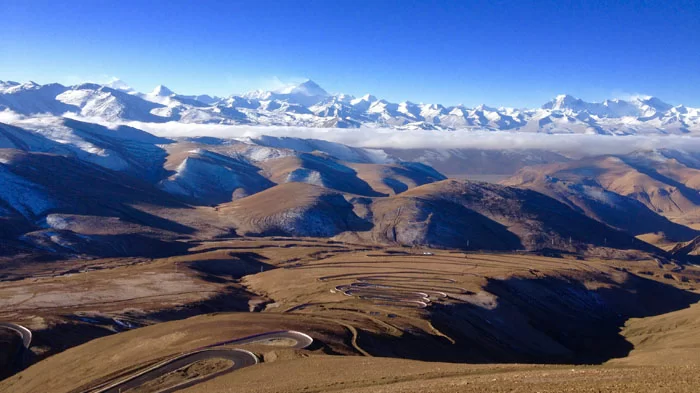 The Gawula Pass offers a spectacular view of the Himalayas.
The Gawula Pass offers a spectacular view of the Himalayas.
Those so-called “Eight-Thousanders” in the Tibet Plateau include:
● K2 - 8,611 m (28,251 ft)
● Lhotse - 8,516 m (27,940 ft)
● Makalu - 8,485 m (27,838 ft)
● Cho Oyu - 8,188 m (26,864 ft)
● Dhaulagiri I - 8,167 m (26,795 ft)
● Manaslu - 8,163 m (26,781 ft)
● Shishapangma - 8,027 m (26,335 ft)
7. There are a total 8 mountain ranges in the Tibetan Plateau
When it comes to mountain ranges on the Tibetan Plateau, the most frequently mentioned ones are the Kunlun Mountains in the north, the Himalayas, and the Karakoram Range in the south. However, it's important to acknowledge the Hengduan Mountains in the east, also referred to as the Daxue Mountains or the Alps of Sichuan.
In addition, we shouldn't overlook the Gangdise Mountains, located in the southwest of the Tibetan Autonomous Region (TAR), and the Tanggula Mountains in the northeast, which separate Tibet from the Qinghai province. The sacred Mount Kailash in the Gangdise Mountains is believed to be the centre of the universe for Buddhists, Hindus, Jains, and Bon religion.
In northern Tibet, the Koh Xil Mountains serve as a boundary between Tibet, Xinjiang, and Qinghai provinces, while the Nyenchen Thanglha Mountains traverse the TAR, bisecting the region. When you travel to Lake Namtso, you can enjoy the stunning view of these snow-capped mountain ranges.
8. The Tibetan Plateau used to be an ocean
It can be hard to believe at first but it’s a well-established fact that the Tibetan Plateau used to be underwater as a part of the old Bangong-Nujiang Ocean. If you haven’t heard of that ocean before, that’s probably because it doesn’t exist anymore – it stopped being an ocean during the Late Cretaceous period when the deposition of continental red beds led to a massive intracontinental convergence.
Still, it is quite fascinating that a region that high above the sea level today used to be so far below it years ago.
9. Not only Tibetans live on the Tibetan Plateau
The Tibetan Plateau is named after the Tibet region and the Tibetan people are indeed at the heart of that region. However, some other ethnic groups and cultures can also be encountered when visiting this wondrous place.
Ethnic groups such as the Sherpa, Qiang, Tamang, Lhoba, and Monpa all contribute greatly to the cultural melting pot that is the Tibetan Plateau as do many Han and Hui Chinese people.
10. The Tibetan Plateau offers the longest highland railway in the world
The Qinghai - Tibet Railway is both the longest and the highest railway in the world to date. As such, it’s also one of the most impressive engineering achievements in the world.
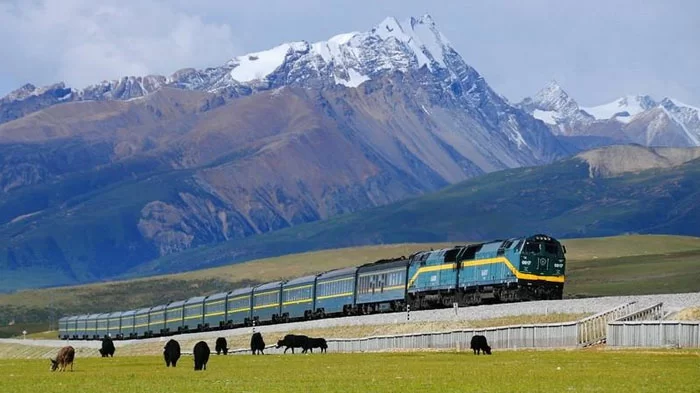 The Qinghai - Tibet Railway is both the longest and the highest railway in the world to date.
The Qinghai - Tibet Railway is both the longest and the highest railway in the world to date.
Moreover, the train to Tibet provides an extraordinary experience as it traverses the Tibetan Plateau, starting from the city of Xining in Qinghai Province and reaching Lhasa, the capital of the Tibetan Autonomous Region. This remarkable railway journey offers passengers the opportunity to witness some of the most breathtaking views found anywhere on the planet.
11. The Tibetan Plateau also has high-speed Railways
In addition to its extensive high-altitude Qinghai-Tibet railway, the Tibetan Plateau boasts remarkable high-speed railways. The Lhasa-Nyingchi and Lhasa-Shigatse railways reach impressive top speeds of 160 km/h. Notably, the Lhasa-Nyingchi railway holds the distinction of being Tibet's first electric railway, adding to the region's technological advancements in transportation.
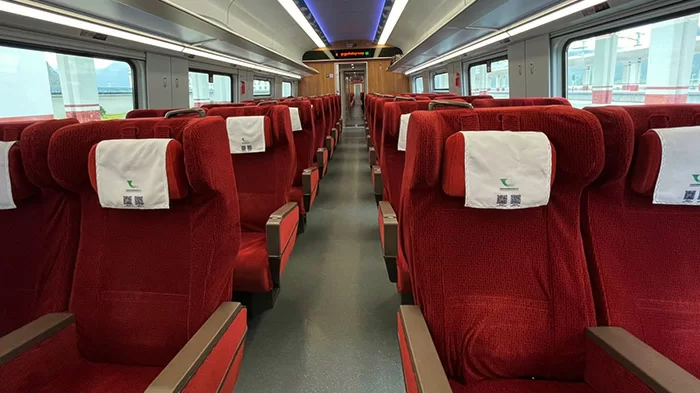 The First-class Seat on Lhasa Nyingchi High-speed Train
The First-class Seat on Lhasa Nyingchi High-speed Train
12. The once-isolated Tibetan Plateau now has airports, railway stations, and highways
The previously secluded Tibetan Plateau has experienced significant development, with the establishment of airports, railway stations, and highways. These modern transportation infrastructures have connected the region to the outside world, enabling easier access for visitors and promoting economic growth.
 The Lhasa GongGa Airport enabling easier access for visitors Tibet.
The Lhasa GongGa Airport enabling easier access for visitors Tibet.
The once-isolated plateau now stands as a testament to progress and improved connectivity, opening up new opportunities for exploration and cultural exchange.
13. The Tibetan Plateau is the source of the major rivers in Asia
Being known as "the Third Pole" and housing one of the largest ice reserves globally, it's no surprise that the Tibetan Plateau serves as the source of numerous major rivers that traverse China and the continent.
These rivers include the Yangtze River (6,300 km) flowing into the Pacific through China, the Yellow River (5,464 km) with a similar route, and the Lancang River (4,880 km) passing through China, Myanmar, Laos, Thailand, Cambodia, Vietnam, and more.
If you visit Tibet by train, you’ll also have the chance to see the gorgeous Source of Three Rivers Nature Reserve in Qinghai on board.
 The Tibet train will via the Three Rivers Nature Reserve.
The Tibet train will via the Three Rivers Nature Reserve.
14. You may see snow in summer at some mountain passes in the Tibetan Plateau
In the Tibetan Plateau, known as the Roof of the World, it is common to witness snow at mountain passes even during the summer months.
During an overland trip across the Tibetan Plateau, you may encounter an intriguing phenomenon: while the lower regions bask in the sunshine, ascending in altitude reveals the remarkable sight of snowdrifts at mountain passes. This distinctive landscape, characterized by the coexistence of sun-drenched valleys and snowy peaks, can only be experienced in the high-altitude realms of the Plateau. It adds an element of wonder and awe to the journey, showcasing the diverse and captivating nature of this extraordinary region.
15. There are Large temperature differences between day and night on the Qinghai-Tibet Plateau
If you’ve seen the famous one-sleeve Tibetan robes and clothes, you may have wondered what’s the reason behind this design choice. It’s simple – the differences between the day and night temperatures in the Tibetan Plateau are so stark that one-sleeve cloaks help people thermoregulate.
For you, as a tourist, this means that you should always pack a coat or two for the night, even if you’re visiting Tibet during the summer.
Conclusion
These quick 15 points are just a sample of the many unique features of the Tibetan Plateau and the wonders it offers to tourists from across the globe. In reality, we’d need libraries of books to describe all the thousands of fantastic aspects of that part of the world. Still, if you want to learn more you can also check out the rest of our website. Or, maybe even consider visiting Tibet sometime?

The Lhasa-born prodigy used to study business overseas, and got his Bachelor of Business in Nepal and India before moving back to his homeland. With pure passion for life and unlimited love for Tibet, Kunga started his guide career as early as 1997.
Responsible, considerate, and humorous, he devoted his entire life to guiding and serving international tourists traveling in Tibet. As a legendary Tibetan travel guru with 20-year pro guide experience. Currently, he is working in Tibet Vista as the Tour Operating Director. Whenever our clients run into trouble, he is your first call and will offer prompt support.
Related Articles & Posts
Most Popular Tibet Tour Packages
-

Lhasa - Gyantse - Shigatse - Everest Base Camp - Shigatse - Lhasa
USD939
View Details -

Lhasa - Gyantse - Shigatse - E.B.C - Saga - Kailash Trek - Darchen - Lake Manasarovar - Saga - Gyirong - Tingri - Lhasa
USD2059
View Details -

10 Days Lhasa to Everest Base Camp and Namtso Lake Small Group Tour
Lhasa - Gyantse - Shigatse - EBC - Shigatse - Lhasa - Namtso Lake - Damxung - Lhasa
USD1289
View Details -

8 Days Driving Across Himalaya Overland Adventure from Kathmandu to Lhasa
Kathmandu - Gyirong - Everest Base Camp - Tingri - Shigatse - Gyantse - Lhasa
USD1069
View Details -

4 Days Lhasa Impression Small Group Tour: Explore the Heart of Tibet and Mingle with the Locals
Lhasa
USD509
View Details -

Lhasa - Gyantse - Shigatse - Everest Base Camp - Gyirong - Kathmandu
USD979
View Details -

Lhasa - Gyantse - Shigatse- Lhasa
USD799
View Details -

13 Day Lhasa, Mt. Everest, Mt. Kailash, Lake Manasarovar and Kathmandu Adventure Tour
Lhasa - Gyantse - Shigatse - EBC - Saga - Darchen - Kailash Trek - Darchen - Saga - Gyirong - Kathmandu
USD2059
View Details


.jpg)



